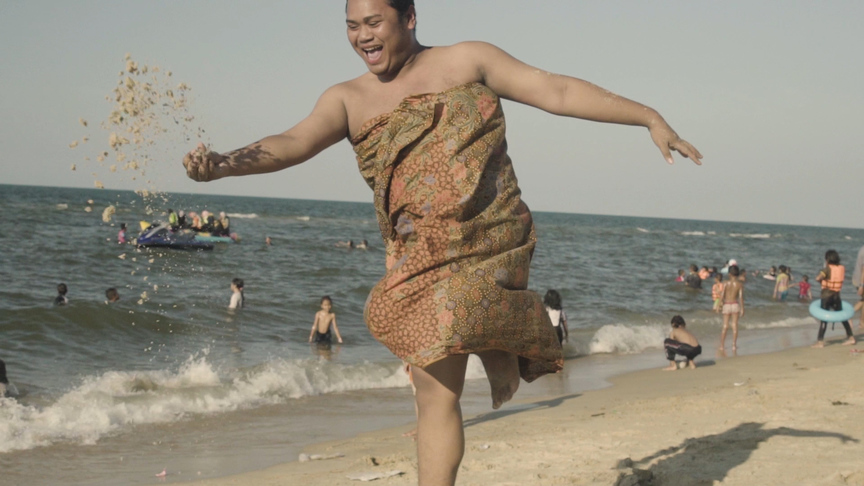-
From Current Issue
-
- Editor’s Letter Fire in the Heart
- Reviews I Gusti Ayu Kadek Murniasih
- Reviews 11th Seoul Mediacity Biennale: “One Escape at a Time”
- Dispatch Networked China
- One on One Monira Al Qadiri on Yukio Mishima
- Essays The rise of independent art spaces in pandemic-era Shanghai
- Features Tuan Andrew Nguyen
- Table of Contents
- Web Exclusives
- Archive
- Subscribe

R
E
V N
E
X
T
Installation view of “Bad Bodies” at Tomorrow Maybe, Hong Kong, 2019. Photo by Xin Li. Courtesy Eaton Hong Kong.
“Bad,” as defined by the dictionary, means to be of poor quality or a low standard; unfavorable. The term is typically understood in binary opposition to “good,” and together, the dichotomous pair plagues the way that we subjectively perceive and assess. Curator Nick Yu’s “Bad Bodies” at Hong Kong’s Tomorrow Maybe was a group show that sought to redefine “bad” through an LGBTQ framework, and in doing so, remediate the way the word has been applied to queer bodies—echoing the way “gay” and “queer” were reclaimed by members of the community from a hetero-patriarchal context.
Held in an alcove in the gallery was Rob Crosse’s Prime Time (2017), which follows a group of older gay men, dubbed the “Prime Timers,” as they holiday through the Caribbean on a cruise ship. Utilizing various perspectives, including close-up shots, Crosse captured the community’s intimate moments as they naturally unfolded, both in the private domain, such as a bathroom where a topless man is captured shaving, and in public, where two other men are seen in swimsuits, talking and applying sunscreen. Conventionally, these older bodies are refused representation as they contrast what ageist and capitalist societies promote as the ideal. In Crosse’s piece, they are depicted tenderly, evoking the question of how we came to define the narrow window of time that we understand as our “prime.” The continuous motion of the waves and the immutable horizon line in the video further underscored, by way of metaphor, the never-ending cycle of desire—one that is perpetuated by the unrealistic and discriminating ideals that pervade society.
Water, or more broadly, liquid, was a motif that subtly threaded through the works in the gallery space. In Samak Kosem’s video Neverland (2017), the waves that repeatedly lap against a beach bring to mind the obstinate societal forces that queer and racialized bodies face. The work follows a non-binary character who runs along gleefully in an imaginary land that has no traditional definitions of gender. In reality, the film is set on a shore in a predominantly Muslim part of south Thailand. Viewers see glimpses of the reactions of passersby, ranging from angry glares and nervous, awkward chatter to children’s laughter, intermingled with Islamic teachings that are broadcast from a mosque close by.
Similarly tackling repressive conditions is Mary Maggic’s Housewives Making Drugs (2017). In the video—a mock cooking-show and biohacking tutorial—trans housewives demonstrate how to concoct “estrogin,” a cocktail of gin and estrogen hormones gathered using a “urine-hormone extraction recipe.” Host Maria exclaims that the elixir will allow “trans women to gain radical body autonomy.” Such satirical remarks are speckled throughout the video as a means for the artist to discuss body and gender politics, and the institutional oppression of trans bodies.
EISA JOCSON, Princess Studies: Fantasy, Work and Happiness, 2015, still from in-progress video documentation of performance with the artist and Joshua Serafin at Para Site, Hong Kong, 2015: 31 min 46 sec. Courtesy the artist.
Maggic’s fight against heteronormative systems is echoed in Eisa Jocson’s Princess Studies: Fantasy, Work and Happiness (2015), a video centered on Filipino performers at Hong Kong’s Disneyland. There, these performers play anonymous and asexual supporting roles, rather than the archetypal heroic princes and feminine princesses. In the piece, two performers appear initially to be perfect embodiments of the character Snow White—blowing kisses, speaking in falsetto—but the act evidently becomes more strained. Finally, they strip off their costumes to reveal “queer bodies of color,” as Yu describes in his curatorial text. Jocson’s work compels viewers to re-evaluate their own preconceptions of what constitutes a “good” princess, and in turn, what conditions deemed these performers as the “bad” alternatives. By the same token, the artist critiques the normalization of racial profiling, which is intertwined with the long-standing oppression of people of color and the ingrained acceptance of white bodies as standard bearers.
The show presented an insightful treasury of video works that exemplify the many ways that “bad” can be reconfigured, while providing a platform where the intricate and multifaceted politics of identities and bodies was authentically explored. The gallery became an inclusive space where “bad bodies” were shown with pride, “hack[ing] the hegemonic systems of patriarchy, hetero- , and homo-normativity.”
Xuan Wei Yap is an editorial intern of ArtAsiaPacific.
“Bad Bodies” is on view at Tomorrow Maybe, Hong Kong, until June 30, 2019.
To read more of ArtAsiaPacific’s articles, visit our Digital Library.



















